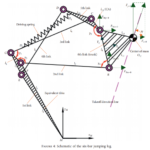Paper, Design, Optimization, and Experiment on a Bioinspired Jumping Robot with a Six-Bar Leg Mechanism Based on Jumping Stability
A jumping leg with one degree of freedom (DOF) is characterized by high rigidity and simple control. However, robots are prone to motion failure because they might tip over during the jumping process due to reduced mechanism flexibility. Mechanism design, configuration optimization, and experimentation were conducted in this study to achieve jumping stability for a bio-inspired robot. With locusts as the imitated object, a one-DOF jumping leg mechanism was designed taking Stephenson-type six-bar mechanism as reference, and kinematic and dynamic models were established. The rotation angle of the trunk and the total inertia moment were used as stability criteria, and the sensitivity of different links to the target was analyzed in detail. With high-sensitivity link lengths as the optimization parameters, a configuration optimization method based on the particle swarm optimization algorithm was proposed in consideration of the different constraint conditions of the jumping leg mechanism. Optimization results show that this method can considerably improve optimization efficiency. A prototype of the robot was developed, and the experiment showed that the optimized trunk rotation angle and total inertia moment were within a small range and can thus meet the requirements of jumping stability. This work provides a reference for the design of jumping and legged robots.
Learn about our two Decals!
 Click here to find out more about our Fall Bioinspired Design Decal and our Spring Bioinspired Design in Action Decal – ALL MAJORS are welcome.
Click here to find out more about our Fall Bioinspired Design Decal and our Spring Bioinspired Design in Action Decal – ALL MAJORS are welcome.Berkeley BioDesign Community
 Click here to learn about the BioD: Bio-Inspired Design @ Berkeley student organization or here to signup for more info.
Click here to learn about the BioD: Bio-Inspired Design @ Berkeley student organization or here to signup for more info.Search
Student Login




I imagine that the neurological circuits underlying these processes are governed by both 2d spacing maps with their brains as…
to reduce the impact of car accidents, it may be possible to study the force diverting physics of cockroaches to…
you see this type of head-bobbing stability in many avian creatures related to pigeons like chickens. the head ability to…
not like they taught horses how to run! this is an example of convergent evolution where both sea creatures and…
The brain functions in a similar way with neuronal connections. our brains are able to utilize the multiplicity of connections…